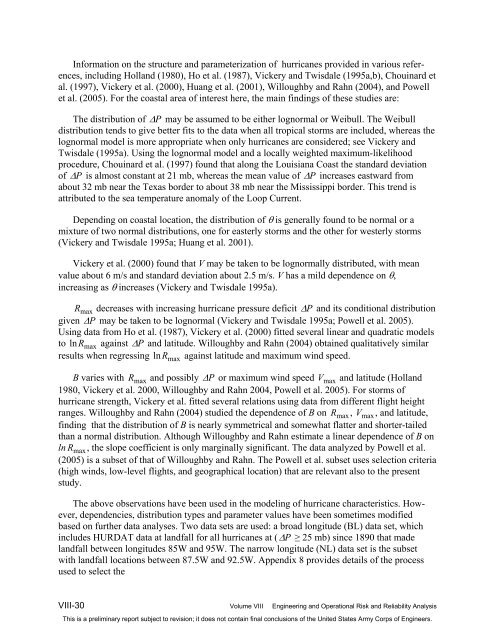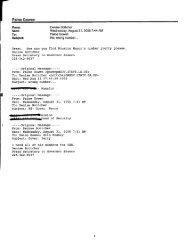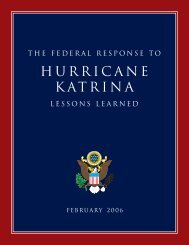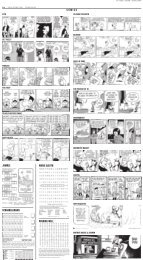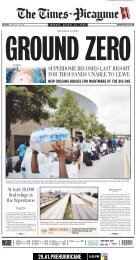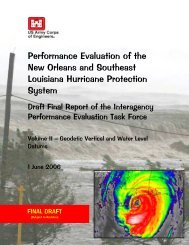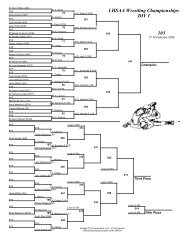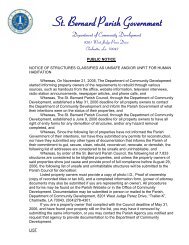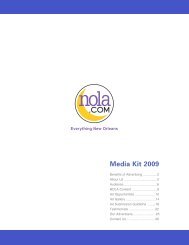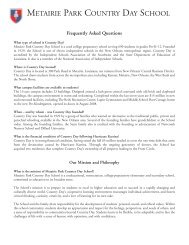IPET Report 3 Vol VIII
IPET Report 3 Vol VIII
IPET Report 3 Vol VIII
You also want an ePaper? Increase the reach of your titles
YUMPU automatically turns print PDFs into web optimized ePapers that Google loves.
Information on the structure and parameterization of hurricanes provided in various references,<br />
including Holland (1980), Ho et al. (1987), Vickery and Twisdale (1995a,b), Chouinard et<br />
al. (1997), Vickery et al. (2000), Huang et al. (2001), Willoughby and Rahn (2004), and Powell<br />
et al. (2005). For the coastal area of interest here, the main findings of these studies are:<br />
The distribution of ΔP may be assumed to be either lognormal or Weibull. The Weibull<br />
distribution tends to give better fits to the data when all tropical storms are included, whereas the<br />
lognormal model is more appropriate when only hurricanes are considered; see Vickery and<br />
Twisdale (1995a). Using the lognormal model and a locally weighted maximum-likelihood<br />
procedure, Chouinard et al. (1997) found that along the Louisiana Coast the standard deviation<br />
of ΔP is almost constant at 21 mb, whereas the mean value of ΔP increases eastward from<br />
about 32 mb near the Texas border to about 38 mb near the Mississippi border. This trend is<br />
attributed to the sea temperature anomaly of the Loop Current.<br />
Depending on coastal location, the distribution of θ is generally found to be normal or a<br />
mixture of two normal distributions, one for easterly storms and the other for westerly storms<br />
(Vickery and Twisdale 1995a; Huang et al. 2001).<br />
Vickery et al. (2000) found that V may be taken to be lognormally distributed, with mean<br />
value about 6 m/s and standard deviation about 2.5 m/s. V has a mild dependence on θ,<br />
increasing as θ increases (Vickery and Twisdale 1995a).<br />
R max decreases with increasing hurricane pressure deficit ΔP and its conditional distribution<br />
given ΔP may be taken to be lognormal (Vickery and Twisdale 1995a; Powell et al. 2005).<br />
Using data from Ho et al. (1987), Vickery et al. (2000) fitted several linear and quadratic models<br />
to lnR max against ΔP and latitude. Willoughby and Rahn (2004) obtained qualitatively similar<br />
results when regressing lnR max against latitude and maximum wind speed.<br />
B varies with R max and possibly ΔP or maximum wind speed V max and latitude (Holland<br />
1980, Vickery et al. 2000, Willoughby and Rahn 2004, Powell et al. 2005). For storms of<br />
hurricane strength, Vickery et al. fitted several relations using data from different flight height<br />
ranges. Willoughby and Rahn (2004) studied the dependence of B on R max, V max, and latitude,<br />
finding that the distribution of B is nearly symmetrical and somewhat flatter and shorter-tailed<br />
than a normal distribution. Although Willoughby and Rahn estimate a linear dependence of B on<br />
ln R max, the slope coefficient is only marginally significant. The data analyzed by Powell et al.<br />
(2005) is a subset of that of Willoughby and Rahn. The Powell et al. subset uses selection criteria<br />
(high winds, low-level flights, and geographical location) that are relevant also to the present<br />
study.<br />
The above observations have been used in the modeling of hurricane characteristics. However,<br />
dependencies, distribution types and parameter values have been sometimes modified<br />
based on further data analyses. Two data sets are used: a broad longitude (BL) data set, which<br />
includes HURDAT data at landfall for all hurricanes at (ΔP ≥ 25 mb) since 1890 that made<br />
landfall between longitudes 85W and 95W. The narrow longitude (NL) data set is the subset<br />
with landfall locations between 87.5W and 92.5W. Appendix 8 provides details of the process<br />
used to select the<br />
<strong>VIII</strong>-30 <strong>Vol</strong>ume <strong>VIII</strong> Engineering and Operational Risk and Reliability Analysis<br />
This is a preliminary report subject to revision; it does not contain final conclusions of the United States Army Corps of Engineers.


